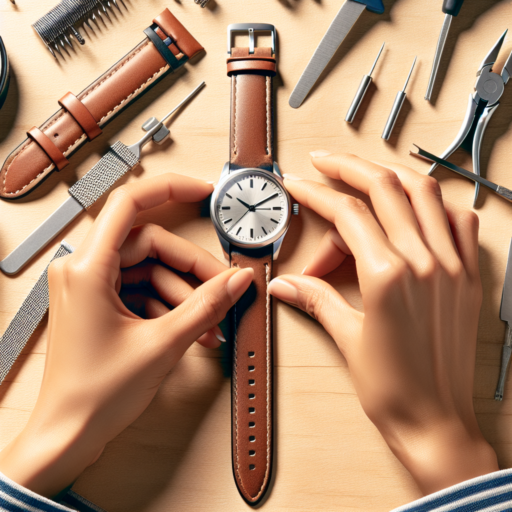Is it easy to switch watch bands?
Many watch enthusiasts and everyday users alike often ponder over the question: Is it easy to switch watch bands? The short answer is yes, it can be quite straightforward, provided you have the right tools and a basic understanding of the watch’s mechanism. Switching watch bands is a simple way to customize your timepiece to match your style or the occasion.
Firstly, the process largely depends on the type of watch and the band’s attachment mechanism. Most modern watches are designed with user convenience in mind, featuring quick-release mechanisms that allow for easy band swapping without the need for specialized tools. However, traditional watches might require a small screwdriver or a spring bar tool to carefully remove and replace the bands.
Steps to Switch Watch Bands
- Identify the attachment mechanism: Look for quick-release levers or determine if you need a tool for a spring bar.
- Prepare your workspace: Work over a soft surface to avoid scratching the watch or losing small parts.
- Remove the old band: Use the appropriate method to detach your current band from the watch casing.
- Attach the new band: Align the new band with the watch lugs and secure it in place, ensuring it is snug and secure.
With a plethora of watch bands available in the market, from luxurious leather straps to durable metal bracelets and sporty silicone options, switching bands can rejuvenate the look of your watch. Although the task may seem daunting at first, with a little practice, it becomes a quick and effortless way to enhance and personalize your watch-wearing experience.
Can you interchange watch bands?
Absolutely, interchanging watch bands is more than just a possibility—it’s a commonly employed method for watch enthusiasts to personalize and refresh their timepieces. This versatility allows individuals to tailor their accessories to match different occasions, outfits, or even moods.
Types of Watches That Support Interchangeable Bands
Not all watches are created equal when it comes to the ease of swapping bands. Traditional watches with standard lug widths and smartwatches designed with band interchangeability in mind, such as the Apple Watch or various Fitbit models, are particularly conducive to this customization. It’s essential to understand the compatibility and mechanism of your watch to ensure a successful band exchange.
Materials and Styles
The array of available band materials and styles is vast, offering an opportunity to significantly alter the look and feel of your watch. Options range from leather, silicone, and nylon to metal and rubber. Each material boasts its unique attributes, influencing not only the aesthetic but also the comfort and durability of the watch band. The style, whether it be a classic leather strap, a sporty silicone band, or an elegant metal bracelet, can completely transform your watch’s appearance.
Impact of Regular Swapping
Regularly changing your watch band can breathe new life into your watch, ensuring that it continues to complement your evolving style preferences and needs. However, it’s important to proceed with caution to avoid wear and tear on the watch’s lugs and the bands themselves. Using the proper tools and techniques for band interchangeability will help maintain the integrity and longevity of your timepiece.
No se han encontrado productos.
What if I don’t have a spring bar tool?
If you’re looking to adjust or replace the band on your watch but find yourself without a spring bar tool, don’t worry. You’re not completely out of options. A few household items can sometimes serve as a makeshift tool for dealing with spring bars, albeit with extra caution to avoid damaging your watch.
Alternative Tools You Can Use
One common substitute is a small flathead screwdriver, preferably one thin enough to fit into the space where the spring bar sits. Paper clips, when straightened, can also work in a pinch. They can be inserted into the hole of the spring bar and used to compress it. Lastly, toothpicks or eyeglass screwdrivers might serve as another solution, though these require a gentle touch to prevent breaking within the mechanism or scratching your watch.
When using any of these alternatives, it’s crucial to operate with care. Protect the surrounding area of your watch with tape to minimize scratch risks. Always work on a clean, flat surface, and keep your watch steady to prevent slippage. Remember, these methods are not foolproof and come with a higher risk of damage compared to using the proper tool. Therefore, they should only be considered temporary solutions until you can acquire a spring bar tool.
How often do you need to change a watch band?
Understanding the frequency with which you should change your watch band is crucial for maintaining both the aesthetic appeal and functionality of your watch. Different factors play a role in determining this timeframe, including the material of the band, the amount of wear and tear it undergoes, and personal style preferences.
The material of your watch band is a key factor in its longevity. For instance, leather bands are susceptible to damage from sweat and water, leading to quicker wear which might necessitate changes every 6 to 12 months. In contrast, metal bands can last for years with proper care, although they might require occasional tightening of their links. Silicone or rubber bands, favored for their durability and flexibility, are ideal for active lifestyles and may only need to be replaced every couple of years unless they show significant signs of wear or damage.
Keeping an eye on the condition of your watch band is essential. Signs such as cracking, fading, and the overall loss of elasticity are clear indicators that it’s time for a replacement. For those who prioritize personal style, swapping out watch bands can also be a way to refresh the look of your watch without having to purchase a new timepiece altogether.




